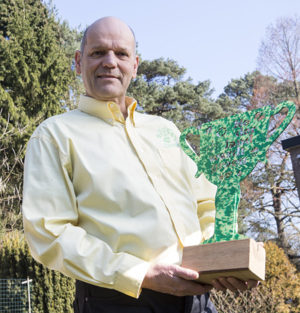Anton van den Broek had the idea for the little helpers seven years ago. “Many people in my neighborhood live in old, very poorly insulated houses,” he says. “They don’t have much money, but they have to pay a lot for energy. I wanted to help them lower those costs by reducing their energy consumption.” His idea was a radiator fan comprising three fans and mounted under the radiator to quickly and uniformly distribute the heat. But at first his idea couldn’t be implemented due to a lack of funds.
Over lunch two and a half years ago, he told his coworker Pieter van der Ploeg about his idea. Van der Ploeg is managing director of “GO!”, a company that boosts the energy efficiency of apartment buildings. Van der Ploeg was convinced right away. “I decided to take up the idea and implement it,” he says. He went to work with the engineers Arnold Halbertsma and Henk de Groot and developed the Speedcomfort radiator fan. The three got together every Tuesday afternoon to work on the product.
Environmentally friendly European production
For the heart of the application, the three fans, they immediately chose ebm-papst. The two engineers had worked for a long time in the ventilation sector and knew the fan specialist well. And the start-up wanted environmentally friendly, European production.

Pieter van der Ploeg presenting the award for the greenest idea of the Netherlands (Photo | Marcel Bonte)
The product they chose was a DC axial fan. “To cool a room, you need a lot of air flow. But if you only want to circulate the air better, you don’t want to feel any wind,” explains van der Ploeg. To keep the speed as low as possible, ebm-papst in St. Georgen redesigned the winding. And the team installed the fans for the application, which are normally used for LED cooling, in a rectangular housing instead of a round one.
Everything went very quickly. Van der Ploeg and the two engineers began planning in the spring of 2015. Implementation with ebm-papst began in July, and in November the prototype of the Speedcomfort radiator fan had already won the prize for Holland’s greenest idea. That put the company under pressure. “We began sales in the web shop in December, two months earlier than planned,” says van der Ploeg. “That was tough, but it was also a sign that the market had been waiting for a product like this.” Series production began in January 2016.
Simple installation
A key to the product’s success is certainly its simple installation. Anyone can click it into place under a radiator using four magnets and then plug it in. The device has a built-in temperature sensor and starts running as soon as the radiator reaches a temperature of 35 degrees. Then the three fans assist the flow of warm air and circulate it uniformly throughout the room. It can barely be heard and makes the room more comfortable. The Speedcomfort’s operating cost is only 16 cents per year.
That’s how SpeedComfort works:
Sustainable in every way
It also reduces the heating system’s flow temperature significantly. Normally the residents have to set the water temperature in their heating systems to 80 degrees to warm up the room slowly, but with the Speedcomfort radiator fan, 60 degrees is enough for a warm and cozy home. That means less oil, gas or coal is needed for heating, and households can use up to 30 percent less energy. And the world benefits from lower CO2 emissions. If one quarter of the households in the Netherlands would use the Speedcomfort system, the little country on the North Sea could cut CO2 emissions by a billion kilograms.
“With Speedcomfort, we’ve developed a product that’s sustainable in every way,” says van der Ploeg. The unit consists of materials produced with renewable resources. The manufacturer has also set itself some social goals: Speedcomfort is assembled by people with mental or physical handicaps who would be unable to participate in normal job market.
Coming soon to Germany
Thus far, the radiator fan is only available in three models in Holland and Belgium. Pieter van der Ploeg hopes to be able to sell it in the German market soon; therefore, he is looking for sales partners, who ideally should share the same grand vision: “We want to make the world better, reduce our CO2 emissions and stop climate change.”

Leave a comment